Day 2 of a three day Early Summer Tour today, including a Nightjar Evening. After a grey and cloudy start, it gradually brightened up and then the skies cleared from the west around midday, producing a lovely sunny afternoon. We spent the day down in the Norfolk Broads, then the evening looking for owls and Nightjars.
We started the day with the long drive down to the Broads. There had been a 1st summer male Red-footed Falcon at Hickling Broad reported yesterday and we were hoping to see that and some Swallowtails too. As we got out of the minibus at the NWT car park, several Willow Warblers were singing in the trees nearby and the Peacocks at the next door animal rescue charity were calling too (unfortunately that one doesn’t count!).
We set off down towards the track to Stubb Mill, which was where the falcon had been, stopping on the corner for our first scan. We could immediately see several distant Hobbys in the dead trees out in the reedbed. As we had hoped, the falcons were yet to really get going, with the cloudy start to the day. We could see a small group of other birders further up Whiteslea track, on the bank, looking for the Red-footed Falcon.
We were just debating which way to go, when we noticed a local birder walking back along the track towards us, so we asked him for an update. He told us there was no sign of the Red-footed Falcon this morning and he also suggested that most of the later reports yesterday related to misidentified Hobbys. So it looked increasingly like it hadn’t roosted in the trees here with the Hobbys overnight as we had thought it might have done, and had probably moved swiftly through yesterday. He did tell us about some Garganey on the pools, and we figured we would continue on down the track towards Stubb Mill to see what else we could see.
A couple of Common Whitethroats were flitting around in the bushes by the track ahead of us as we walked along. We had just stopped opposite the second of the pools to scan for the Garganey, when one of the group spotted a Common Crane flying in over the fields behind us. It disappeared behind the trees then reappeared over the track ahead of us, flying out over the pools, before circling round and dropping down into reedbed beyond. A nice start.
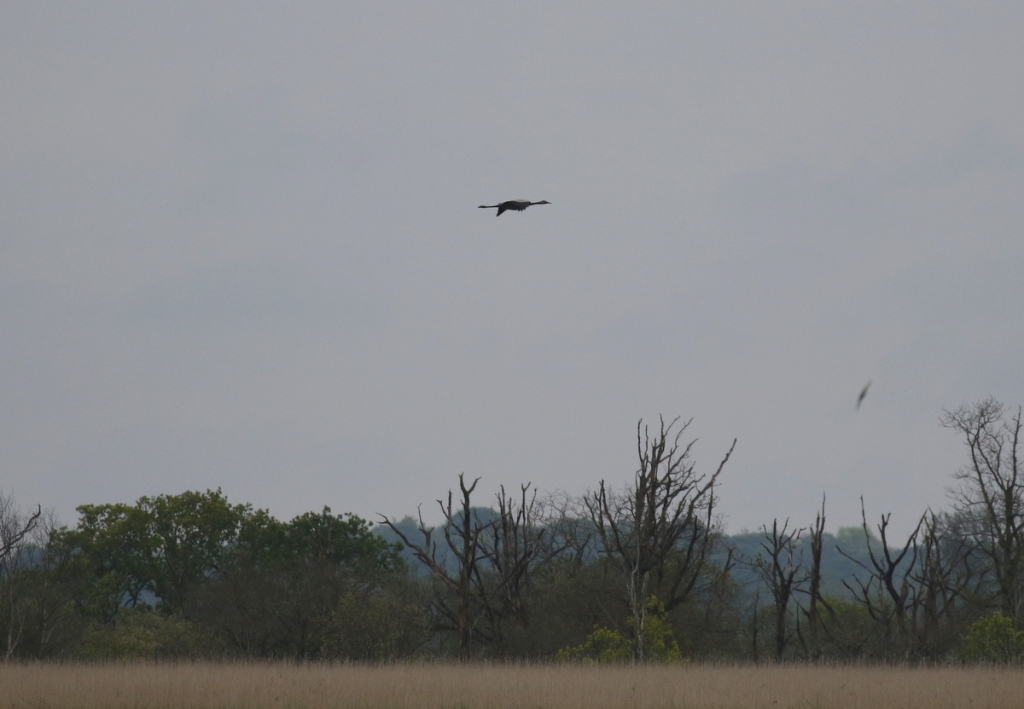
There were lots of hirundines and Swifts hawking low over the pools, including several Sand Martins. It was a good opportunity to compare them with the House Martins. A Common Buzzard and a Marsh Harrier circled high over the trees behind us now. A small group of Black-tailed Godwits were roosting on the short grass by the water. Several Lapwings were flying round calling, and there were a few Avocets out here too.
Most of the ducks were asleep, mainly Gadwall and a few Mallard, plus a single Wigeon and a couple of Teal out on the water beyond. Scanning carefully, we finally found the Garganey, two exclipse drakes in their drabber, female-like plumage, also asleep. For no apparent reason, one of the Avocet decided to run at them, and they woke up briefly, then moving further towards the bank where we couldn’t really get a clear view of them any more. Very helpful of the Avocet!
One of the group was looking at four distant Greylags flying over the back of the reedbed and noticed a large brown bird below. It was a Bittern flying across. Unfortunately it quickly dropped back down into the reeds before all the rest of the group could get on it.
We continued on to where track goes up onto the bank. We were a bit closer to the dead trees and had better views of the Hobbys from here, although it was starting to brighten up and the Hobbys were becoming more active, flying up hawking for insects.
We could see a pair of Ringed Plovers on one of the islands on the pool in front of us, one of which looked to be incubating. They were noticeably paler above than the tundrae Ringed Plovers we had seen at Titchwell yesterday. There were also a couple of Redshank on here and a couple of Common Terns flew over. A Bittern appeared again, from behind the dead trees over the reeds at the back, but again it was distant and hard to pick up against the trees.
We decided to walk back and up the track towards Bittern Hide, hoping for a better view of its namesake. There were several dragonflies flying around now – Four-spotted Chasers – and more damselflies in the vegetation by the path, including Large Red, Azure and Blue-tailed Damselflies.

We walked up Whiteslea Track now, and a Treecreeper was singing in the trees as we passed. We took the path up onto the bank and scanned the pool, picking up an Egyptian Goose from round on this side. Then we continued on towards the hide. A Bittern flew up again, but again was only up for couple of seconds and some of the group still hadn’t seen one, so we stood for a while on the corner before Bittern Hide. We scanned the reeds, but it didn’t reappear. Four more Cranes circled up slowly in the distance. Behind us, we could see the edge of the front which had brought all the cloud and the skies slowly cleared from the west to sunshine.
We heard Bearded Tits pinging and turned to see a couple fly across the ditch in front of us. A female perched in the edge for a few seconds. Some more Bearded Tits were calling further along, in the reeds by the path, and the male climbed up briefly into the tops, before flying and dropping back in. It seemed like they might have young in here. A couple of times the male flew out across the track and then back in with food.
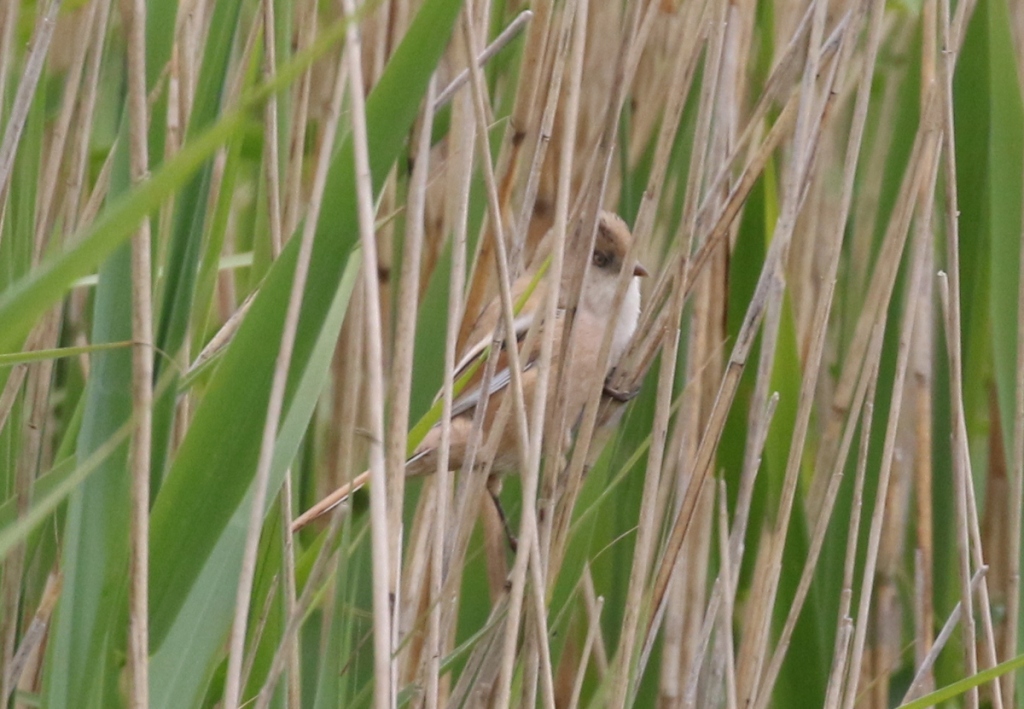
It was time to head back for lunch now. We had seen an adult Black-headed Gull walking around on the top of the bank earlier, which seemed odd, and now we realised why. A fluffy Black-headed Gull chick had walked out of the long grass on the edge of the path. We waited for it to go back in before we walked on. A female Common Blue butterfly was nectaring on a buttercup.
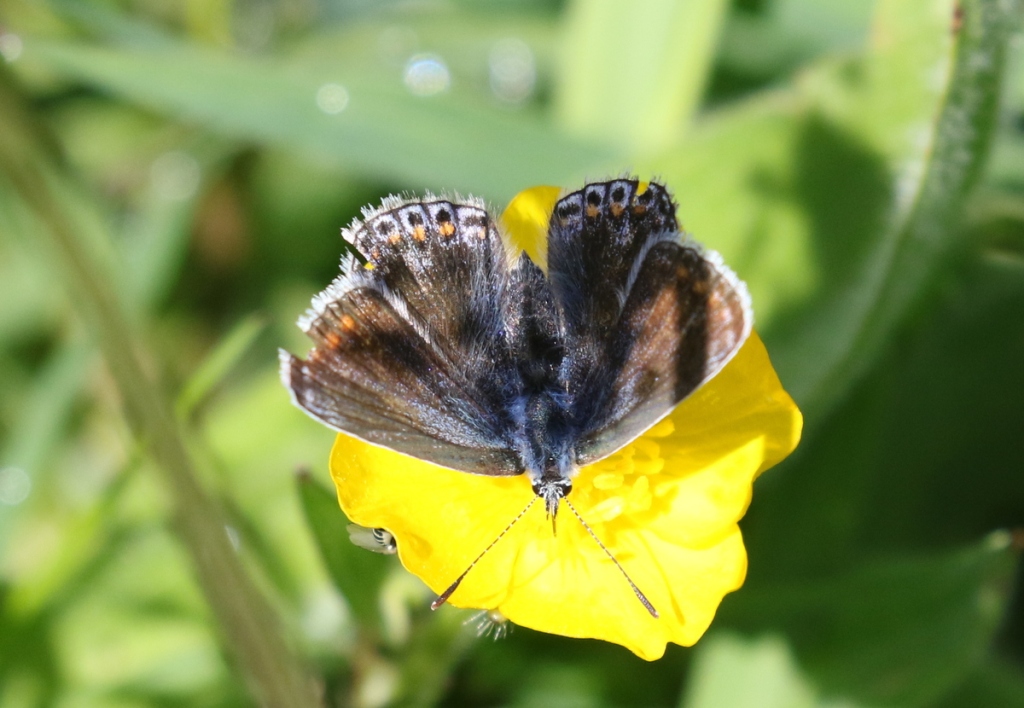
We cut across on the path through the wood, back to the Visitor Centre. There were several Four-spotted Chasers warming themselves on the brambles here in the sunshine. A male Reed Bunting was gathering food and flew across into a dead tree. A Common Whitethroat flitted in and out of the trees ahead of us.
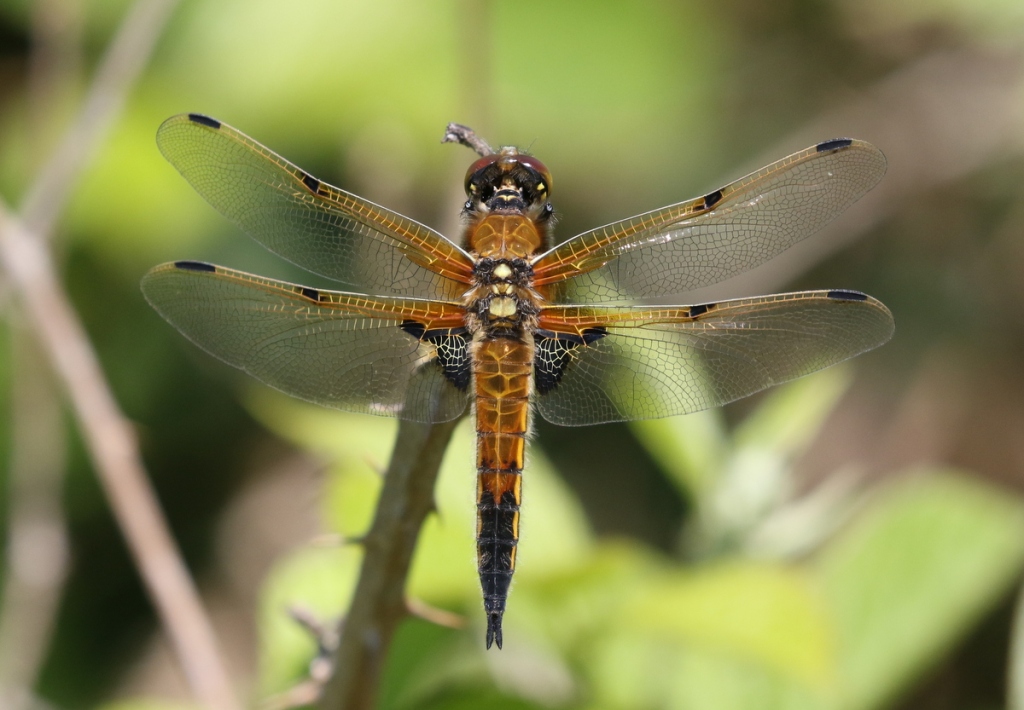
We had our lunch in the picnic area in the sunshine. A Garden Warbler was singing in the trees nearby briefly. Our initial plan was to go somewhere different after lunch, but we had to be back early and didn’t have much time now, and figured we could look for Swallowtails here and maybe have another chance for the members of the group who had not caught any of the Bittern flights earlier.
It was warm now, as we set off again. We walked the other way round the reserve this time, out past the hides, towards the Broad, following the Covid one-way system. A couple of Reed Warblers showed well in the young reeds next to path. When we stopped to look at a male Reed Bunting singing in the top of a dead tree, a Great Spotted Woodpecker flew out of the trees behind and overhead.
We stopped to scan one of the overgrown ditches. There were several more dragonflies here, including a Hairy Dragonfly as well as more Four-spotted Chasers. A small shoal of Common Rudd was in the open water amongst the marestail.
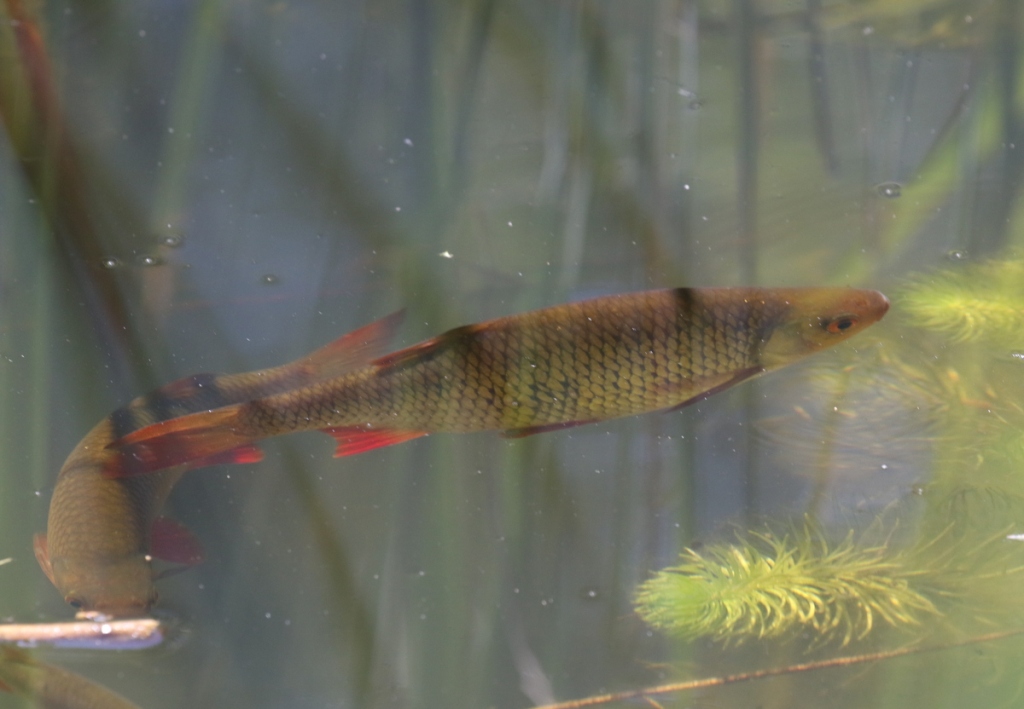
We stopped again at the first viewpoint overlooking the Broad. There were lots of Mute Swans out on the water, but not much else – often the way with the actual Broads themselves. A Marsh Harrier circled over in the sunshine. Continuing along the path, several Willow Warblers were calling in the sallows, collecting food, and one perched right in the top of an alder, singing.
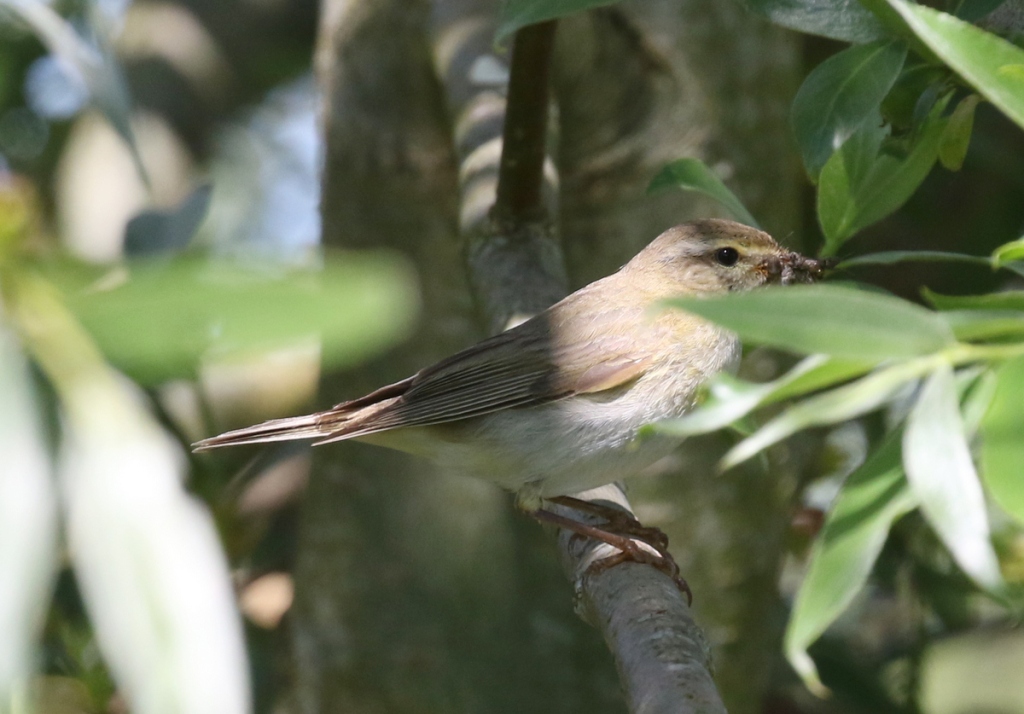
We were struggling at first to find any Swallowtails or any flowers out for them to nectar on. Everything is very late this year after the cold spring. Finally, along the path towards the Observation Hide a Swallowtail flew in. But it carried on straight past us, flying very quickly ahead of us along the path. We tried to follow to see if it might land, but then it turned behind some sallows out of view and by the time we got there we had lost track of it.
We had yet another brief glimpse of a Bittern flying over the reeds, over by Bittern Hide, so we decided to head straight round that way. We popped into the hide. The reeds which had been cut in front of the hide are now growing up fast and making it harder to see anything on there. We were running out of time slightly, as we had to be back early today ahead of our evening foray later, but we decided to have a quick rest in the hide, before heading back to car park.
Scanning the dead trees in the distance through binoculars, there were still one or two Hobbys around. When a falcon flew out head on towards us we assumed it was just another Hobby, but it looked to have a rather pale crown and head which appeared to catch the sun, unlike the dark hood of a Hobby or a male Red-footed Falcon (like yesterday’s). But there was a lot of heat haze now and it was a long way off, so we figured we were imagining it. It turned and landed back in the dead trees out of view behind a branch.
It flew out again, another short sally after insects, and it really did look to have a pale head. As it turned to head back to the trees, it looked to have pale orangey underparts too. It couldn’t be though could it? Yesterday’s Red-footed Falcon was a 1st summer male and this one looked like a female. It lLanded again, and this time we realised we needed to get it in the scope quickly. Now we could confirm what we thought we had seen – it was a female Red-footed Falcon!
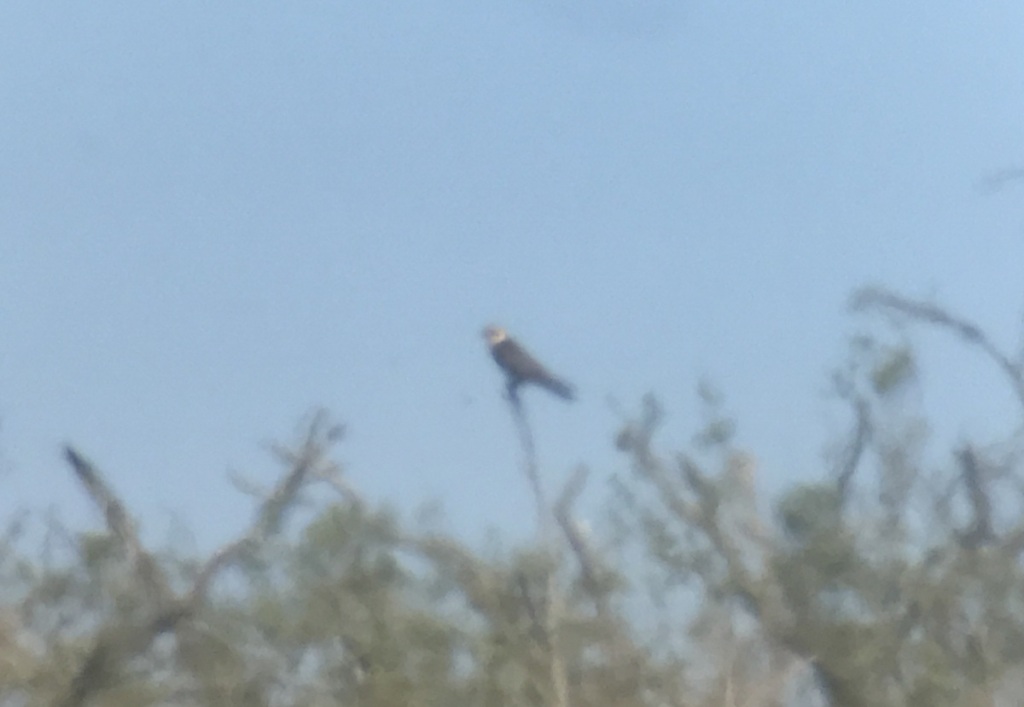
The Red-footed Falcon was distant and there was a lot of heat haze, but we could see it did have a pale head, orange on top, whiter on the cheeks, with a thin black mask and small moustache. The back and wings looked rather dark grey and the underparts pale orangey-buff. It kept doing little sallies from the trees, shorter flights than the Hobbys, with more gliding, and quick bursts of wingbeats when chasing prey. It even did a brief hover. At one point it landed in the same tree as one of the Hobbys, and was noticeably a little smaller, more compact.
We had come to see someone else’s Red-footed Falcon, been disappointed to find it gone, but then found our own. Hickling is a good site for them and hosted multiple birds just last year, presumably the gathering of Hobbys helping to pull in passing birds. We put the news out – but when we went outside and onto the bank we could see everyone else had long since given up and gone. We were thinking it might be a bit closer from bank, but there was still lots of heat haze. Still what a great bird!
Unfortunately it was really time to go now, or we would be late for our early evening meal. As we set off to walk back, another Swallowtail flew past. This time it turned in front of us and looked like it might land on the flowers growing on the bank. It meant we had a better view, but it changed it’s mind and flew off rather than land. Then it was a quick walk back to the car park and a long drive back home, albeit with a spring in our steps!
Nightjar Evening
After a break and something to eat, we met again early evening. We went looking for Little Owls first. We checked out some barns by the road, but there was no sign. So we tried another site and immediately spotted one perched on the roof half way down one of the barns, enjoying the evening sunshine. We got it in the scope.
While we were watching it, another Little Owl flew across in front, disappearing into the trees nearby. After a few seconds it came back out and landed on the ground by the barns, running around looking for food on the concrete. It then flew up again, then across to the other side, perching on the near edge of the roof the other side. Great views.
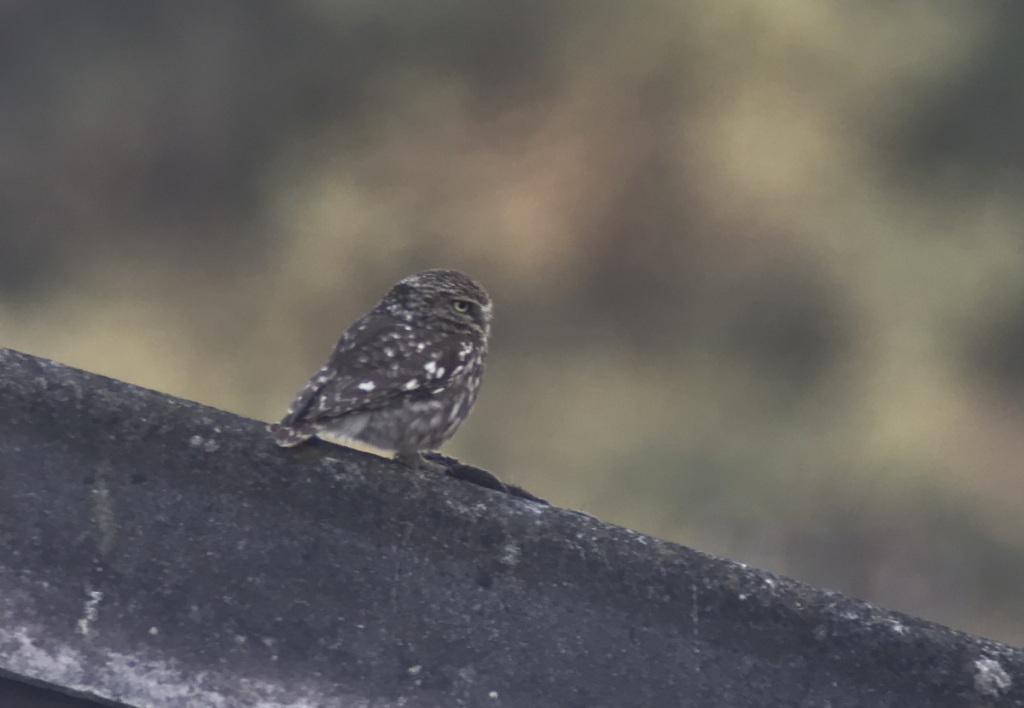
We dropped down towards the coast to look for Barn Owls next. It was a lovely evening, and we heard several Yellowhammers singing through the open windows as we drove down the country lanes. We drove a quick circuit round via some meadows where they like to hunt, without any success, so we parked up nearby and walked up onto the seawall to scan the marshes. At first, we couldn’t find any owls – but we did see several Brown Hares and a pair of Grey Partridge down in the grass. A Song Thrush was singing from the trees on the far side.
Then a Barn Owl appeared out of the trees, the regular very white one, nicknamed ‘Casper’, which is well known here. It started hunting around a recently cut grass field, we watched it fly round, drop into the grass a couple of times, then come back up. It disappeared behind some trees and looked like it had gone off in the other direction, but then reappeared and flew back towards us. It came much closer, flying past us over the reeds and out along the bank across the marshes. It landed briefly, and we thought about going out for a closer look, but it quickly too off again as some people walked past and we watched it head out away from us.

It was time to head up to the heath. The sun had already gone down and the temperature was dropping when we arrived and got out of the minibus. We set off out onto the middle of the heath, and we were not even already in position when we heard our first Nightjar churring. We got out of the edge of the trees just in time to hear it stop and take off wing-clapping. We could see it flying round over the gorse further up, and watched it drop down behind the vegetation ahead of us. We walked quickly on down the path but when we got to the area it had seemed to drop, it had disappeared.
Another Nightjar started churring now, right out in the middle. We stopped to listen to it, such an evocative sound, of summer evenings on the heaths. For some time we could only hear one. It flew round at one point – the churring stopped and we heard it wing-clapping as it took off. Then it flew back to the trees where it had been and resumed churring.
When another Nightjar started up behind us, it sounded closer. We walked on to see if we locate this one, but it was still too far from path to give us a chance to find it. A fourth male then started churring in the distance, and we stood and listened to the two of them for a couple of minutes. A Woodcock flew over roding – we could hear its squeaky call, and looked up to see it fly over with exaggerated slow wingbeats. A Tawny Owl called from the trees.
The first male Nightjar we had seen earlier started churring again, so we walked back. It was getting darker now, so we couldn’t see where it was perched on the edge of the trees. It took off and we watched two Nightjars chasing each other through the tops, silhouetted against the last of the light in the sky. One came back down into the gorse not far from us, and we had a quick view of it flying round lower as it broke the skyline. Then it went quiet again.
One of the other Nightjars was still churring out in the middle. We stood and listened to that for a couple more minutes, a lovely way to while away a summer’s evening. Then it was time to head back – it had been a long day, and we had another busy one ahead tomorrow. As we walked off the heath, we were serenaded by another of the Nightjars churring. It was in a tree above the path but too dark to see it perched now. As we walked underneath, we watched it fly out, dropping down out across the Heath.
















